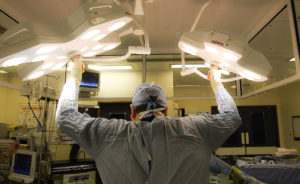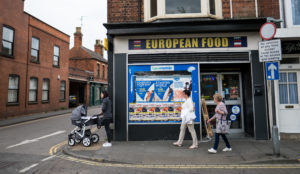Will Britain, as Rishi Sunak and Jeremy Hunt have both promised, really turn into the “next Silicon Valley”? It is bold talk. Some might say Panglossian. Although in truth, perhaps it’s to be expected from a weak administration troubled by divisions, haunted by former leaders and struggling to shake off the impression that it is the last-gasp government of a party worn out after largely wasting 13 years in power.
But we should not be too harsh on Sunak and Hunt, even if their supposed plans to turbocharge growth through harnessing of technology look skeletal. Prime ministers must pretend to have purpose while chancellors must talk up economic prospects by pushing back against tides of negativity. After the latest data showed Britain’s economy to be flatlining rather than contracting, Hunt insisted it was “more resilient than many feared”. But if you really want to see the sorry state of our economy and our nation’s struggles to adapt to the fast-changing world, take a look at one sector that is laden with national symbolism and long been a bellwether for our economic health.
This is the British car industry, a production hub reliant on sophisticated supply lines and a proven beacon of innovation. It is a sector that has shown an uncanny ability to reflect the zeitgeist through its rollercoaster ups and downs since the Second World War. It boomed after the birth of mass motoring, then crashed in spectacular style amid industrial strife, before its careful restoration with a woman driver at the wheel. Now it is being allowed to rot again, partly thanks to the stewardship of a glossy magazine’s former motoring columnist. Perhaps we should have been more alarmed by Boris Johnson’s cavalier approach to cars when we discovered he had racked up £4,000 in parking tickets for GQ.
Once it was the world’s second biggest, but now our shrivelling car sector has sunk to the fringe of the top 20, just behind Slovakia and one place ahead of Iran. Last year, we produced 775,014 cars. This was the fewest since 1956 — a time when an Austin A30 cost £529, a gallon of petrol was 22p (or four shillings and six pence in “old money”) and there were no motorways. There were only 3.3 million drivers, roughly one-tenth of the numbers cramming our roads today, some no doubt humming along to that year’s biggest hit by Pat Boone. Almost all their cars were made in this country by five makers — Nuffield/BMC, Ford, Rootes, Standard-Triumph and Vauxhall — and three of them were British-owned.
Britain also possessed a thriving collection of smaller-scale makers with more than 60 marques, such as Aston-Martin, Jaguar, Jensen, Lotus and Rolls-Royce — more than any other country. Think of the swinging Sixties and you might think of stylish Minis, an icon of British culture born in 1959 that was such a clever and distinctive design it was acclaimed as the most influential car of the 20th century after the Ford Model T. Or the gorgeous E-Type Jaguar, which even the great Enzo Ferrari acclaimed as “the most beautiful car ever made” after its launch in 1961.
Yet at start of that glitzy decade, barely a generation after the war’s end, our car production slid below Germany. Four years later, Daihatsu’s Compagno became the first Japanese car on sale in this country, and by the mid-Seventies — when, badly managed and beset by strikes, we had sunk to sixth place in the global league table as car manufacturers — it became a sorry totem for the disturbing decline of British industry. Post-imperial Britain seemed to be slumped in a gloomy haze of mediocrity, driving haplessly along the slippery road to nowhere. It felt like the whole country was in a slow-motion tailspin.
Nothing symbolised this pervasive sense of despair and dysfunction more than British Leyland. The conglomerate — which brought together brands such as Austin, Mini, Morris, Rover and Jaguar into one supposed national champion — was spared from bankruptcy in 1975 by nationalisation. It was infamous for poor management, dire industrial relations and toxic union firebrands such as Derek “Red Robbo” Robinson. The cars it churned out were often shoddy — just as Japan was ironing out flaws in its vehicles as an emerging industrial superpower. Even clunky but cheap Soviet-built Ladas started selling decently in Britain, a damning indictment of our own state-run behemoth. No wonder the floundering firm became the butt of jokes in Fawlty Towers.
The car industry, like the wider economy, was salvaged during Margaret Thatcher’s controversial reign. She opened the nation’s doors to globalisation, sold off or shut down nationalised industries, brutally stripped away barriers to trade and slashed the power of union barons. But she was also sufficiently pragmatic to recognise the role of targeted state aid — as shown with her leading part in persuading Nissan to open its landmark plant in Sunderland by throwing in subsidies, lobbying both its boss and the Japanese prime minister to land the deal and then opening the site. Honda had already started production in Swindon on a site that once built Spitfire planes, Toyota soon followed suit in Derbyshire. The prime minister used their arrival to show that Britain was on the road to revival as a stable European base for industry.
This sparked a renaissance for Britain’s car industry that lasted three decades, with famous traditional marques often falling into foreign hands. When owners from overseas arrived to buy up dreary brands such as Rover, there was talk of betrayal and sell-out on both Left and Right. Yet car makers from Germany, India, Japan and the United States invested heavily, creating an impressive cluster of innovation that rippled through the economy. By 2015, Britain was the base for more manufacturers than anywhere else in Europe, with seven big carmakers, eight premium producers, nine bus builders and scores of niche manufacturers. Such was its importance that eight of the 11 Formula One teams were based in the country, many of them in a cluster around Oxford, to exploit the cutting-edge technology.
This success was led by exports, with sales abroad doubling in a decade, while the 160,000 workers — once infamous for the speed at which they downed tools — had become among the most productive car makers in Europe. Foreign owners skilfully exploited British heritage brands, such as the Minis I saw churned out at the celebrated Cowley car plant in Oxford following their revival by BMW. This was the place where almost a century earlier a former bicycle maker called William Morris had pioneered Britain’s use of Henry Ford’s mass production techniques. But Cowley had also gone on to reflect the industry’s turbulent history with six far-Left splinter groups fighting for shop floor supremacy in the dismal Seventies.
When I visited a decade ago, however, it was a beacon of industrial modernity. ‘‘If we had not changed, we wouldn’t have had any jobs here,” said union convenor Chris Bond, a former member of the Workers’ Revolutionary Party. The high-tech plant had 513 robots in the body shop alone. It employed 3,700 “associates”, all clad in the same black jackets with MINI on the back — admittedly a fraction of the huge numbers working there before, but there had not been an industrial dispute for almost three decades and everyone received bonuses. I was struck when one woman told me she had previously worked in the NHS where “it felt far more like I was working on a production line”.
Since then, however, the industry’s decline has been precipitous, down 10% last year alone and more than halving since the country voted to leave the European Union in 2016. The UK is no longer a major player in the car industry; only yesterday, Ford announced plans to cut 1,300 jobs in the UK over the next three years. Nissans and Toyotas still roll off British production lines, but Honda has departed from Swindon after producing 3.7 million cars on the site, while Nissan ditched its promise to build the next X-Trail SUV in Sunderland. Elon Musk chose Berlin over Britain for his first Tesla factory in Europe. Five months ago, BMW added to the gloom by announcing the end of electric Mini production in Cowley, although it is continuing with petrol and diesel cars until they are banned from sale in seven years’ time.
Clearly Brexit has been a significant factor. Musk stated that the vote made it “too risky” to open his plant, as well as a research and development base, in Britain. Honda denied its closure decision was tied to the rupture with Brussels, but this is a highly complex industry that boomed off the back of the single European market driven so determinedly by Thatcher, with firms relying on Britain for skilled workers and looser labour regulations but on Europe for sales and many components. The crankshaft for one of those Minis I saw being built crossed the Channel three times before installation in Cowley. The slightest friction for such production techniques can be catastrophic for an industry reliant on low margins and high volumes.
It is no coincidence that car production hit a two-decade high in 2016, when 80% of the vehicles were exported and more than half sold in European Union countries. Yet Brexit is just one of the problems facing the industry; it was also hit hard by China’s Covid lockdowns, which impacted supply chains and resulted in a chronic global shortage of semiconductors. And all this disruption came just as the industry was engulfed by a technological revolution, with rapid acceleration into the age of electrical vehicles.
In this brave new world of electric vehicles, assembly plants need batteries from giant production houses known as gigafactories. Ideally, these need to be located nearby since batteries are big and heavy. Yet Britain currently has only one Chinese-owned plant being built next to the Nissan factory in Sunderland. At least 35 are planned or under construction in the European Union, with three in Hungary alone. There was huge hype over Britishvolt, a £3.8 billion beacon of post-Brexit levelling up policies in Northumberland intended to deliver 300,000 battery packs a year. Johnson typically talked it up, claiming Britain would be a world leader in electric cars, “creating hundreds of thousands of jobs”. Then it ran out of money, the Government refused to bail it out, and it collapsed last month.
Andy Palmer, former head of Aston Martin, told the BBC that its collapse was an “unmitigated disaster for the auto industry in the UK”, and he predicted firms would migrate to where batteries are being made. But to put Britishvolt’s demise in perspective, even this ambitious start-up was planned to deliver less than one-fifth of the capacity by 2030 anticipated from two plants in Germany — Tesla’s gigafactory in Berlin plus another being developed by a Chinese firm that is the world’s biggest electronic vehicle battery maker.
Now, think again about the Mini. The first electric version was built at Cowley plant three years ago, but soon all electric models of this British icon will be coming off production lines in Leipzig and eastern China. Last month also saw more troubling news: the pioneering new electric van maker Arrival is restructuring its business and cutting jobs here as it shifts production to North Carolina to take advantage of massive green subsidies being offered for firms buying clean commercial vehicles.
The last three Tory governments have all boasted that Britain will be a world leader in both green energy and electric vehicle manufacturing, seeing car production as a symbol once again of the country’s status in our post-Brexit world. Now we hear the latest prime minister bragging that he will turn the nation into a technology force. Yet behind all the hype and brash talk, one of our most important, innovative and efficient industries is moving abroad thanks to state inertia at a time of fast-moving change. Britain is stuck in the slow lane — and we seem to be ignoring the warning signs flashing on the dashboard before our eyes.
Disclaimer
Some of the posts we share are controversial and we do not necessarily agree with them in the whole extend. Sometimes we agree with the content or part of it but we do not agree with the narration or language. Nevertheless we find them somehow interesting, valuable and/or informative or we share them, because we strongly believe in freedom of speech, free press and journalism. We strongly encourage you to have a critical approach to all the content, do your own research and analysis to build your own opinion.
We would be glad to have your feedback.
Source: UnHerd Read the original article here: https://unherd.com/






